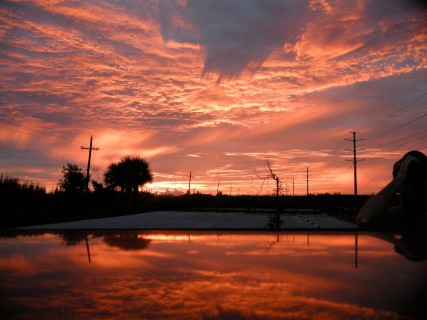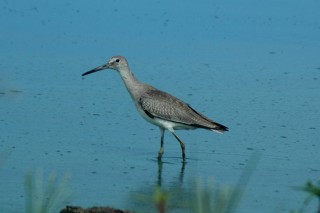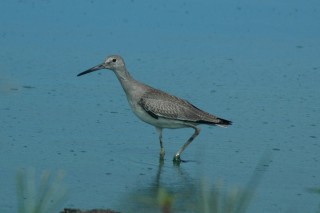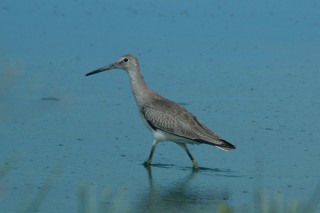As I mentioned last week, you have to start early if you want to beat the August heat when birding the western areas of Palm Beach County. Here’s an example of how early I’m talking about: we’ve been on the road for a half-hour already, and have just made our first stop, STA-1W:
At 10 square miles, most places would probably consider STA-1W to be a giant filtration marsh, but this is Florida real estate: it’s all about location, location, location. Situated at the northwestern edge of a Truly Giant filtration marsh (the 227 square miles of northern Everglades habitat otherwise known as the Arthur R. Marshall Loxahatchee National Wildlife Refuge), these 6670 acres seem pretty small by comparison. This stormwater treatment area (STA) has only recently (within the last couple of years) been brought online; its purpose is to help filter the water that flows south from the Everglades Agricultural Area into the northern Everglades. A side benefit, though, is to create 10 square miles of habitat for wading birds, ducks, and other avifauna.
This morning we found Least Bittern, Pied-billed Grebe, Ruddy Duck, Ring-necked Duck, Blue-winged Teal, and Belted Kingfisher, along with the usual herons and egrets. Least Bittern is always a good bird, and this early in the season, it was nice to find RNDU and RUDU (if you’re a birder and you don’t know your banding codes, you should learn them).
After we left STA-1W, we went a bit farther west along County Road 880 and stopped at some sod fields at 6-Mile Bend. I was hoping to find Upland Sandpiper (UPSA), or perhaps some early-season Buff-breasted Sandpipers (BBSA), but we were unable to score these common but relatively hard-to-find birds. These are Code 1 birds, meaning that they occur widely and regularly in North America, although here in Florida you can only get them on migration. Even down here, though, in most years you should be able to find them—if you go out all the time and if you know where to look, and if you are persistent. I’ve never had the time to devote to that kind of birding, and doubt that I ever will. Which is why either of these would be life birds for me.
We continued on up to the farms, which are the main reason for today’s trip. As I had last Friday in advance of last Saturday’s field trip, Chuck, who is leading next week’s field trip, felt it important to scout the area. And even though I’m not able to make next week’s trip, I felt it important to tag along—after all, whenever you bird with Chuck, there’s a chance of getting some good birds!
As it turns out, the red dawn was a good portent for us; the cloud cover that made the dawn so spectacular held up throughout the day, so we didn’t have to experience the blazing heat we had last weekend. It seemed to help us find birds, too, as we had several more shorebird species than last weekend, and good numbers of them as well: 34 Wilson’s Phalaropes, 8 Willets, dozens of Pectoral and Stilt Sandpipers, and many Western and Semipalmated Sandpipers. We’re actually getting pretty good at separating these last two peeps, because here in Palm Beach County in August at least, many of the WESAs still have red scapulars, while the SESAs are grayer; the semipalms also seem to have a bit more upright posture than the westerns, and, as a final piece of the puzzle, wherever the bird in question is on the short- or long-billed end of the scale, it’s pretty simple to distinguish the shorter-billed SESA from the longer-billed WESA.
In all we had 59 species at the farms, and the trip total was 72. Not bad for a long morning’s work!
Here is a sequence of one of the many Willets (Tringa semipalmata) that we found:
I can’t recall ever seeing Willet out here myself before, although I know that other groups have seen them from time to time. And certainly finding 8 of them makes today stand out as a red-letter day.
But even more exciting was the high count of 34 Wilson’s Phalaropes! That’s a pretty good number for one flooded field. At one point we had a dozen of these little whirling dervish birds in the same telescopic field of view!
On the way back we stopped at 6-Mile Bend again. More on that later, but here’s the complete list of the 72 species we saw today, counting STA-1W, 6-Mile Bend, and the farms:
72 seen
Pied-billed Grebe
American White Pelican
Double-crested Cormorant
Anhinga
Great Blue Heron
Great Egret
Tricolored Heron
Little Blue Heron
Snowy Egret
Cattle Egret
Green Heron
Black-crowned Night-Heron
Yellow-crowned Night-Heron
Least Bittern
Wood Stork
White Ibis
Glossy Ibis
Roseate Spoonbill
Black-bellied Whistling-Duck
Blue-winged Teal
Ring-necked Duck
Ruddy Duck
Turkey Vulture
Osprey
Red-tailed Hawk
Purple Swamphen
Common Moorhen
American Coot
Black-necked Stilt
American Avocet
Black-bellied Plover
Semipalmated Plover
Killdeer
Short-billed Dowitcher
Long-billed Dowitcher
Upland Sandpiper
Greater Yellowlegs
Lesser Yellowlegs
Solitary Sandpiper
Spotted Sandpiper
Willet
Semipalmated Sandpiper
Western Sandpiper
Least Sandpiper
Pectoral Sandpiper
Stilt Sandpiper
Wilson’s Phalarope
Gull-billed Tern
Caspian Tern
Least Tern
Black Tern
Black Skimmer
Mourning Dove
Common Ground-Dove
Common Nighthawk
Belted Kingfisher
Bank Swallow
Barn Swallow
Northern Mockingbird
Blue-gray Gnatcatcher
Loggerhead Shrike
European Starling
House Sparrow
Yellow Warbler
Yellow-throated Warbler
Prairie Warbler
American Redstart
Northern Waterthrush
Common Yellowthroat
Northern Cardinal
Red-winged Blackbird
Boat-tailed Grackle
You might notice that one of the birds above is in red type. Stay tuned!




